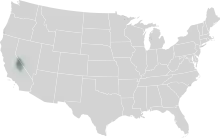Mono language (California)
Mono /ˈmoʊnoʊ/ (Mono: ?) is a Native American language of the Numic group of Uto-Aztecan languages, the ancestral language of the Mono people. Mono consists of two dialects, Eastern and Western. The name "Monachi" is commonly used in reference to Western Mono and "Owens Valley Paiute" in reference to Eastern Mono.[3] In 1925, Alfred Kroeber estimated that Mono had 3,000 to 4,000 speakers. As of 2010 only about 40 elderly people speak Mono as their first language.[3] It is classified as critically endangered by UNESCO.[4] It is spoken in the southern Sierra Nevada, the Mono Basin, and the Owens Valley of central-eastern California. Mono is most closely related to Northern Paiute; these two are classified as the Western group of the Numic branch of the Uto-Aztecan language family.[3][5]
| Mono | |
|---|---|
| Native to | United States |
| Region | California |
| Ethnicity | Mono and Owens Valley Paiute |
Native speakers | (37 cited 1994)[1] |
Uto-Aztecan
| |
| Language codes | |
| ISO 639-3 | mnr |
| Glottolog | mono1275 |
| ELP | Mono (United States)[2] |
 | |
Western Mono
The number of Native speakers in 1994 ranged from 37 to 41. The majority of speakers are from the Northfork Rancheria and the community of Auberry. The Big Sandy Rancheria and Dunlap have from 12 to 14 speakers.[1] The Northfork Mono are developing a dictionary, and both they and the Big Sandy Rancheria provide language classes. While not all are completely fluent, about 100 members of Northfork have "some command of the language."[6] In the late 1950s, Lamb compiled a dictionary and grammar of Northfork Mono.[7] The Western Mono language has a number of Spanish loanwords dating to the period of Spanish colonization of the Californias,[8] as well as loanwords from Yokuts and Miwok[9][10]
Owens Valley Paiute
In the mid-1990s, an estimated 50 people spoke the Owens Valley Paiute language.[1] Informal language classes exist and singers keep native language songs alive.[6] Linguist Sydney Lamb studied this language in the 1950s and proposed the name Paviotso for this language, but that was not widely adopted.[11]
Phonemes
Below is given the phoneme inventory of Northfork Western Mono as presented by Lamb (1958).
Vowels
| front | back unrounded | back rounded | |
|---|---|---|---|
| High | i | y[12] | u |
| Non-High | e | a | o |
Consonants
| Bilabial | Coronal | Palatal | Velar | Uvular | Glottal | |||
|---|---|---|---|---|---|---|---|---|
| plain | lab. | plain | lab. | |||||
| Nasal | m | n | ||||||
| Stop | p | t | k | kʷ | q[13] | qʷ | ʔ | |
| Affricate | ts | |||||||
| Fricative | s | x | h | |||||
| Semivowel | j | w | ||||||
Suprasegmental
Lamb (1958) also described four suprasegmental features that he ascribed phonemic status.
Morphology
Mono is an agglutinative language, in which words use suffix complexes for a variety of purposes with several morphemes strung together.
See also
References
- Hinton, 30
- Endangered Languages Project data for Mono (United States).
- "Mono." Survey of California and Other Indian Languages, University of California, Berkeley. 2009-2010 (retrieved 6 May 2010)
- http://www.unesco.org/culture/languages-atlas/index.php
- Sheldon Klein. 1959. Comparative Mono-Kawaiisu. International Journal of American Linguistics. Vol. 25, No. 4 (Oct., 1959), pp. 233-238
- Hinton, 31
- Miller 101
- Paul V. Kroskrity and Gregory A. Reinhardt. 1985. On Spanish Loans in Western Mono International Journal of American Linguistics Vol. 51, No. 2 (Apr., 1985), pp. 231-237
- Loether, Christopher. 1998. "Yokuts and Miwok Loan Words in Western Mono" in The Life of Language: Papers in Linguistics in Honor of William Bright. Jane H. Hill, P. J. Mistry, Lyle Campbell (eds). Walter de Gruyter, 1998
- Loether, Christopher. 1993. "Nɨ-ɨ-mɨna Ahubiya: Western Mono Song Genres". Journal of California and Great Basin Anthropology Vol. 15, No. 1 (1993), pp. 48-57
- Miller, 98
- Represented phonemically as /y/ by Lamb, but is described as being phonetically [ɨ] after front consonants and [ʉ] after back consonants.
- /k/ and /q/ are in semi-complementary distribution: /k/ occurs before /i/ and /e/, /q/ occurs before /o/ and /u/. They contrast only before /a/.
Sources
- Hinton, Leanne. Flutes of Fire: Essays on California Indian Languages. Berkeley: Heyday Books, 1994. ISBN 0-930588-62-2.
- Miller, Wick R. "Numic Languages." Handbook of North American Indians: Great Basin, Volume 11. Washington, DC: Smithsonian Institution, 1986. ISBN 978-0-16-004581-3.
- Lamb, Sydney M (1958). A Grammar of Mono (PDF). PhD Dissertation, University of California, Berkeley. Retrieved July 8, 2012.
Further reading
- Bethel, Rosalie; Kroskrity, Paul V.; Loether, Christopher; Reinhardt, Gregory A. (1993). A Dictionary of Western Mono. Los Angeles : American Indian Studies Center, University of California.
- Lamb, Sydney M. Monachi dictionary (PDF). Ms., Survey of California and Other Indian Languages. Retrieved July 9, 2012.
- Norris, Evan J. (1986). A Grammar Sketch and Comparative Study of Eastern Mono. PhD dissertation, University of California, San Diego.
Language revitalization
- Onishi, Norimitsu (17 June 2012). "With Casino Revenues, Tribes Push to Preserve Languages, and Cultures". The New York Times. p. 14.
- Charles McCarthy (2007-10-14). "Learning an almost lost language; The few Mono Indians remaining who speak their tongue are passing it down to children to preserve culture". The Fresno Bee. Retrieved 2012-07-09.
- James May (2003-07-11). "Defying the Silence, Part 2: A Race Against Time". Indian Country Today. Archived from the original on 2013-12-20. Retrieved 2012-07-09.
External links
- "Mono Language and the Mono Indian Tribe (Monache, Monachi)". Retrieved 2012-07-09.
- Mono language overview at the Survey of California and Other Indian Languages
- Nuumu Yadoha Language Program: Lessons 1 thru 8 CD, Quick Pronunciation Guide: Lessons 9-16 CD, April 2002, retrieved 2012-07-09
- OLAC resources in and about the Mono language